Follow Wayne Hitchings’ Charity Hike to Everest Base Camp here.
(Newest update first) To donate, click here.
8 July 2016
Thank You!
And so we reach the end of this adventure. Months in the planning, two weeks to complete, and one of the most incredible experiences I could ever imagine. The highlights for me would be the stunning views, the sense of achievement, my All Hands teammates, the warmth of the Nepali people and the amazing support I 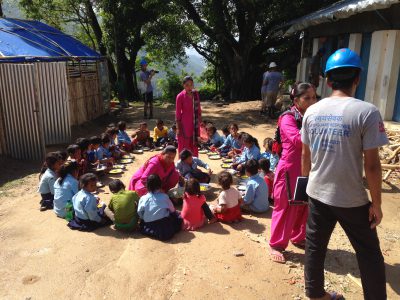 received throughout the journey.
received throughout the journey.
It really was a huge surprise to me that so many of you supported me in one way or another. Whether it was helping me with the fundraising or donating to my page, I felt truly humbled. You helped take my total to a touch under £3,000 and collectively our team raised more than $72,000, every penny of which has gone to building schools in Nepal. Thank you so 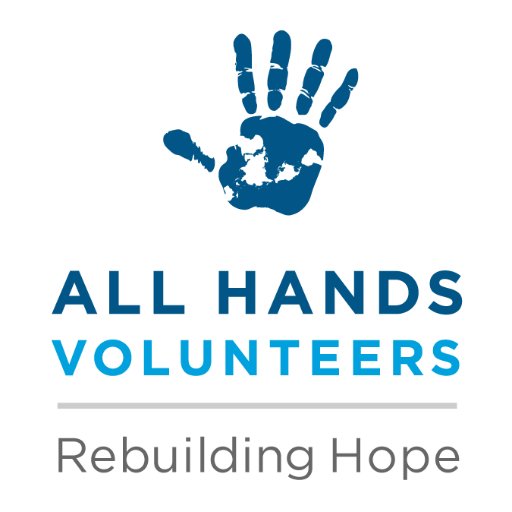 much to each and every one of you.
much to each and every one of you.
A special thank you to Mark and Peter at Roseland Online for allowing me to host the blog on the website. Also for editing the page and their very generous donation.
Hot off the press! – All Hands have just released the Everest Challenge video on their YouTube channel. You can watch it at this link
What next? – On April 16th 2016 a 7.8 Magnitude earthquake hit Western Ecuador killing over 650 people and causing extensive damage to thousands of homes and the country’s infrastructure. 2 days later All Hands Volunteers were on the ground and soon after launched Project Ecuador. In late August this year I shall be going out to join my All Hands family once again.
The challenge may have ended but the need has not. If you have a few minutes please visit the All Hands website at www.hands.org where you can find our about our disaster relief projects across the world and how you can support us in the future.
Thank you
Wayne
2 July 2016
All Hands Volunteers – Earthquake Rebuild Nepal
Rejoining Project Nepal felt great. I took the 4hr journey up to Nuwakot the day after we completed the hike and was really excited to be back among the mix. Of the 3 sites we had to choose from I chose one of the mobile sites, known as Jalpa, in the small village of Kalimati. I chose this option because I knew we’d be embedded among the community we were working for and I really like that. It brings a great connection to the locals get to know you personally.
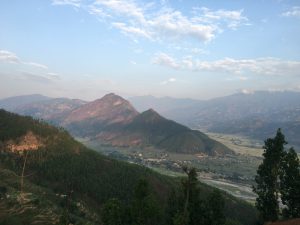 The first thing I noticed on arrival was just how much more humid it was than in Kathmandu. It was oppressive in its intensity but fortunately wasn’t like that every day. On the plus side the view from the campsite overlooked the whole valley and was absolutely stunning. On the first morning we were given a base orientation by our young American project manager, Brett. He ended this talk by mentioning snakes and no sooner had he finished when a 5ft long
The first thing I noticed on arrival was just how much more humid it was than in Kathmandu. It was oppressive in its intensity but fortunately wasn’t like that every day. On the plus side the view from the campsite overlooked the whole valley and was absolutely stunning. On the first morning we were given a base orientation by our young American project manager, Brett. He ended this talk by mentioning snakes and no sooner had he finished when a 5ft long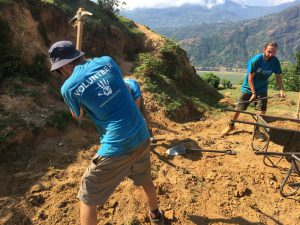 venomous cobra slivered at speed straight through the middle of the camp and into someone’s tent before disappearing into the distance. None of us slept well that night.
venomous cobra slivered at speed straight through the middle of the camp and into someone’s tent before disappearing into the distance. None of us slept well that night.
There were 15 of us working on the school, split into 3 or 4 teams. A rubble team who dug and shifted rocks and dirt to be used for back filling, a re-bar team who would bend the bar that would reinforce the concrete, a ‘Masala’ (meaning mortar) team who would sift the sand, mix the cement and deliver it along with “Eta” (bricks) to the brick layers who made up the final team. I worked predominantly on the brick team along with a couple of other 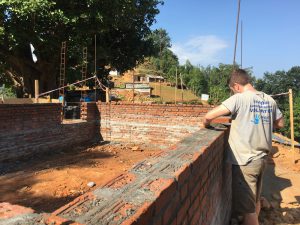 volunteers and four local masons who were employed by the charity. I was incredibly slow compared to the locals but having never laid bricks before I wanted my section of the wall to look as flush as possible and I was quite pleased at the end of the week.
volunteers and four local masons who were employed by the charity. I was incredibly slow compared to the locals but having never laid bricks before I wanted my section of the wall to look as flush as possible and I was quite pleased at the end of the week.
My two favourite parts of the day were ‘snack time’ and ‘high-five time’. At around 4.30pm each day two local people, 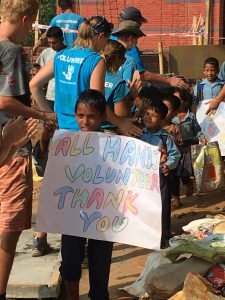 Peter and Sunita, invited us into their respective homes and had made delicious snacks that we could buy. Just before snacks came high-five time. Here we lined up next to the temporary school while the local kids walked along and high-fived us all. One day they even made signs for us to say thank you. This is why we do what we do. Just by being there and giving them hope they repay us with smiles and give us the motivation to get the job done.
Peter and Sunita, invited us into their respective homes and had made delicious snacks that we could buy. Just before snacks came high-five time. Here we lined up next to the temporary school while the local kids walked along and high-fived us all. One day they even made signs for us to say thank you. This is why we do what we do. Just by being there and giving them hope they repay us with smiles and give us the motivation to get the job done.
This is what the money that you have donated pays for. Going directly to the people who need it most. Putting kids back into school. So thank you, every single one of you.
28 June 2016
Disaster Volunteering – What is it like?
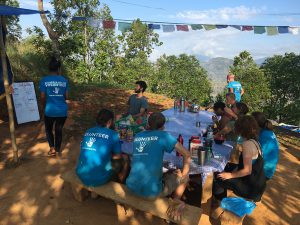
I’ve often been asked what is it like to volunteer in a disaster zone. The living conditions, food, people, bathroom, weather, dangers? It varies from project to project but Nepal has been a good example of the different types. In the Nuwakot region, where All Hands Volunteers efforts are now focused, there are currently 3 separate school building sites and a main base which also acts as the project HQ. When the volunteers from all 3 sites were on base there were 70 people living in a building meant for far fewer. I shared a bunk-bed dorm with 30 others. It doesn’t smell that great but you’re all in the same boat. There were several bathrooms each with a Western style toilet and a cold shower. Breakfast consisted of a bowl of oats, one egg and two pieces of bread. You can supplement that off your own back should you wish.
In contrast once out on site I stayed in my own tent. Out here the breakfast was the same but shower was a ‘bucket shower’. You literally get one bucket of cold water to pour over yourself. The toilet was a hole that we had dug in the
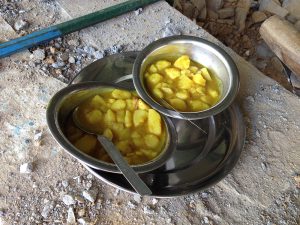
ground. Work began at 7.30am each day and finished at about 4.30pm with an hour for lunch. Generally there is no power and therefore no power tools. Everything is done by hand with shovels, sledgehammers, crowbars, rope, wheelbarrows, trowels and so on. Shifting the rubble, sifting the sand for the cement mix, mixing the cement, digging up dirt for back-fill, everything is done by hand. That’s not easy to do when the temperature is normally above 30 degrees and the humidity very high.
Being in an active seismic zone there is always a risk of further earthquakes. This time around I did not feel any but 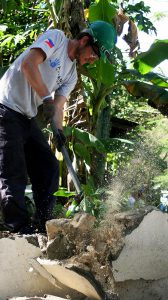 during my first stint in June 2015, I felt several aftershocks. The largest, a Mag 4.8, occurred about 15 mins before we would normally wake up. It was one big jolt, the entire building shifted with it and you’ve never seen 20 people get up off the floor so quickly! Trust me when I say that an aftershock is far more effective than an alarm clock. I find it really interesting that each aftershock I’ve experienced has had a different feel to the last one. Some come as a gentle wave, some start softly and get stronger whilst others come as a single jolt.
during my first stint in June 2015, I felt several aftershocks. The largest, a Mag 4.8, occurred about 15 mins before we would normally wake up. It was one big jolt, the entire building shifted with it and you’ve never seen 20 people get up off the floor so quickly! Trust me when I say that an aftershock is far more effective than an alarm clock. I find it really interesting that each aftershock I’ve experienced has had a different feel to the last one. Some come as a gentle wave, some start softly and get stronger whilst others come as a single jolt.
All of this might make you ask why would you do it? but the rewards are immeasurable. Helping people after they’ve suffered such hardship and seeing their reaction when someone has come along to give them hope. When they realise that these people have come from all over the world to help them, for free, just because they can and they want to, you get the most incredible reaction. You don’t need to be able to speak each others languages to thank someone, you can see it written all over them.
In my next post I’ll talk specifically about the week I had helping to build a school so please stay tuned.
22 June 2016
Days 9-11
Periche – Kathmandu (4,100 – 1,400m)
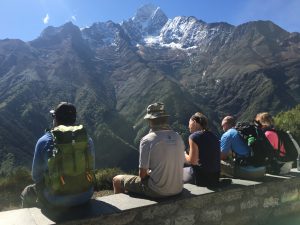 Upon waking in Periche I felt much better than I had done the day before and by lunch time on Day 9 I had fully recovered. Not only that but the lower we got the stronger I began to feel. You had so much energy that you almost started the run the trail and it felt like the oxygen was so thick you could chew on it!
Upon waking in Periche I felt much better than I had done the day before and by lunch time on Day 9 I had fully recovered. Not only that but the lower we got the stronger I began to feel. You had so much energy that you almost started the run the trail and it felt like the oxygen was so thick you could chew on it!
In Periche there is a monument, designed by a British artist, which is a stark reminder of the treacherous environment you have been in. 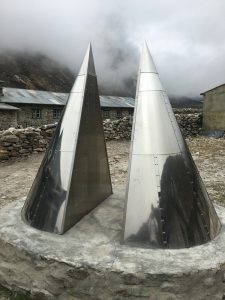 The split cone-shaped structure lists the name of every person that has perished whilst trying to scale Everest. It takes you several minutes to read through all of the names and whilst there I thought back to the 5 people who had died as we were beginning our challenge. When would their names be added?
The split cone-shaped structure lists the name of every person that has perished whilst trying to scale Everest. It takes you several minutes to read through all of the names and whilst there I thought back to the 5 people who had died as we were beginning our challenge. When would their names be added?
The last couple of days for me began to feel a little tedious. Don’t get me wrong, we were still treated to stunning views, had great company, we relaxed more in the evenings and sampled some local beverages but the drive to complete your goal had disappeared and had been replaced with 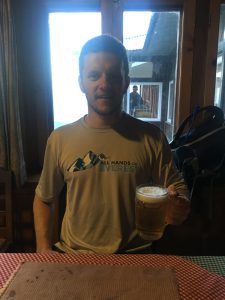 a feeling that you were just waiting to get down.
a feeling that you were just waiting to get down.
It was a mixture of relief and sadness on arrival back in Kathmandu. Relief that i’d successfully completed the challenge in one piece. Relief that we’d successfully negotiated Lukla airport for the second time! and sadness because this incredible adventure was coming to an end. That night I had dinner with the wonderful team of people that i’d shared this experience with. We saw some native dancing and enjoyed lots of laughter. It was a fitting way to end.
Several of the team flew home to their respective countries the next morning but for me it was time to rejoin Project Nepal and so please stay 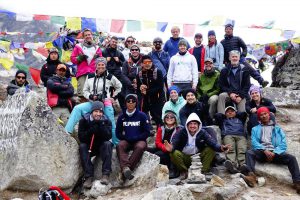 tuned as my next post will be about our school rebuild project. For those of you that have donated you will be able to see exactly what your money is going towards. It is still possible to donate for anyone thinking about it, you’ll find the link at the bottom of this blog.
tuned as my next post will be about our school rebuild project. For those of you that have donated you will be able to see exactly what your money is going towards. It is still possible to donate for anyone thinking about it, you’ll find the link at the bottom of this blog.
Thanks for reading.
17 June 2016
Day 8
Gorak Shep – Kalapathar – Periche (5,100 – 5,640 – 4,100m)
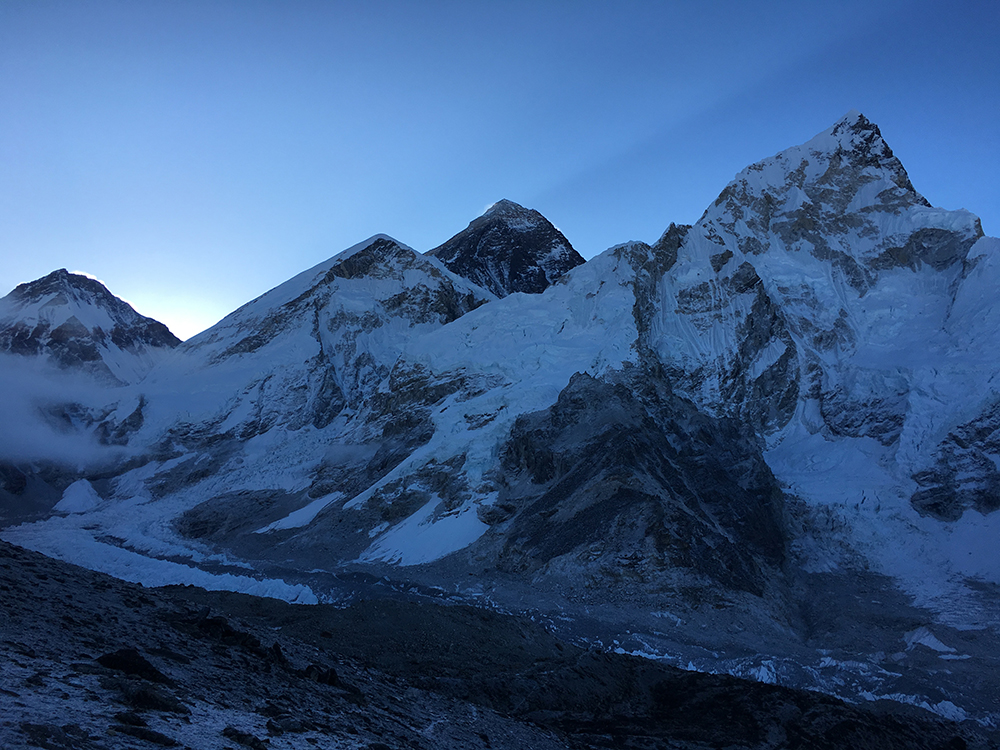
We were woken at 3.45am to start the climb up Kalapatthar. I was feeling terrible and had little sleep after a freezing cold night so decided not to go. However, 15mins later I heard Nema, our lead guide, telling one of my teammates that the weather is perfect and this is the best view of Everest you’re ever going to get. I couldn’t just lay there and let that go so I quickly put on my hiking gear and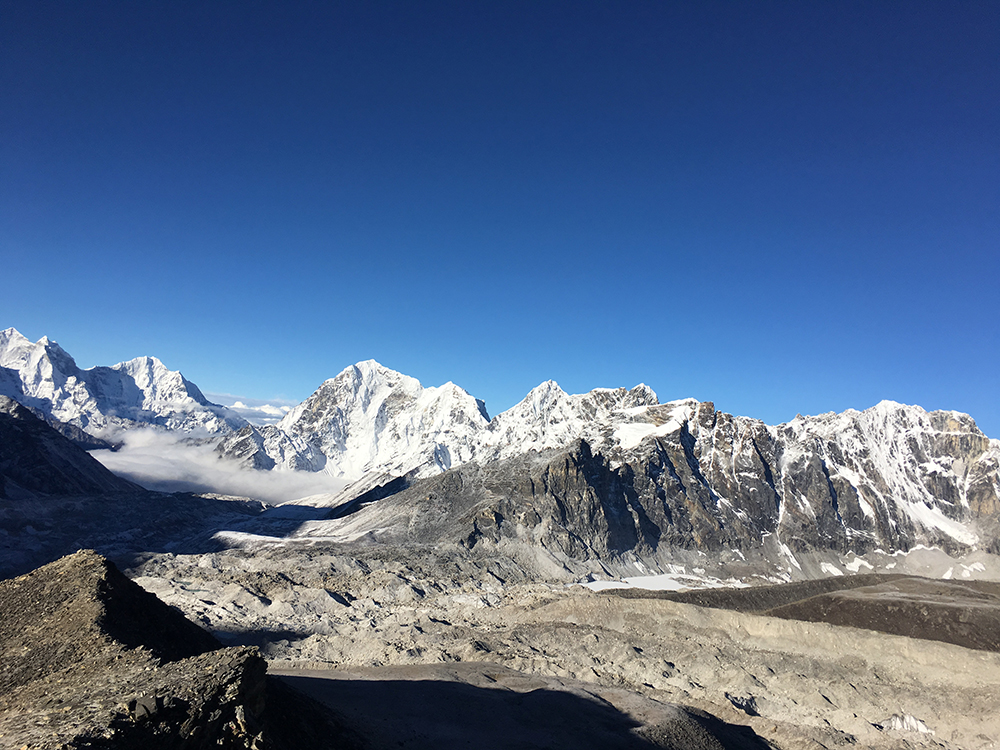 got started. On reaching the summit about 90mins later I felt elated that I’d made it and had never been that high before. I was also blown away by the views of Everest and the other major peaks of the Himalayas. That was where the fun ended.
got started. On reaching the summit about 90mins later I felt elated that I’d made it and had never been that high before. I was also blown away by the views of Everest and the other major peaks of the Himalayas. That was where the fun ended.
On returning to the lodge I felt much worse than before. Now nausea had joined the intense headache, I didn’t want to eat and felt completely exhausted. What I thought was a cold turned out to be altitude sickness.
 I’ve often wondered when I’ve heard that someone has died on Everest due to altitude sickness why they don’t just get down quicker, as this cures the problem. But in my own experience you just can’t move faster because you’re completely exhausted. What that must feel like 3,000m higher than I was and with far worse symptoms, I can only imagine and hopefully never find out.
I’ve often wondered when I’ve heard that someone has died on Everest due to altitude sickness why they don’t just get down quicker, as this cures the problem. But in my own experience you just can’t move faster because you’re completely exhausted. What that must feel like 3,000m higher than I was and with far worse symptoms, I can only imagine and hopefully never find out.
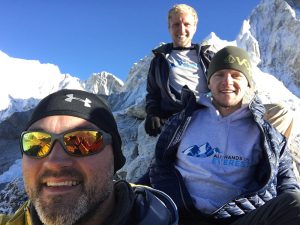
Nema’s son, Prasant, had to carry my backpack that day (as well as his own) as I trudged slowly down the mountain. When we reached our overnight stay in Periche we had dropped more than 1,000m in elevation and although I still felt pretty terrible I was much better than I had been in Gorak Shep. I am extremely grateful to Prasant for helping me.
15 June 2016
Day 7 – 29th May
Lobuche to Everest Base Camp (4,930 – 5,364m)
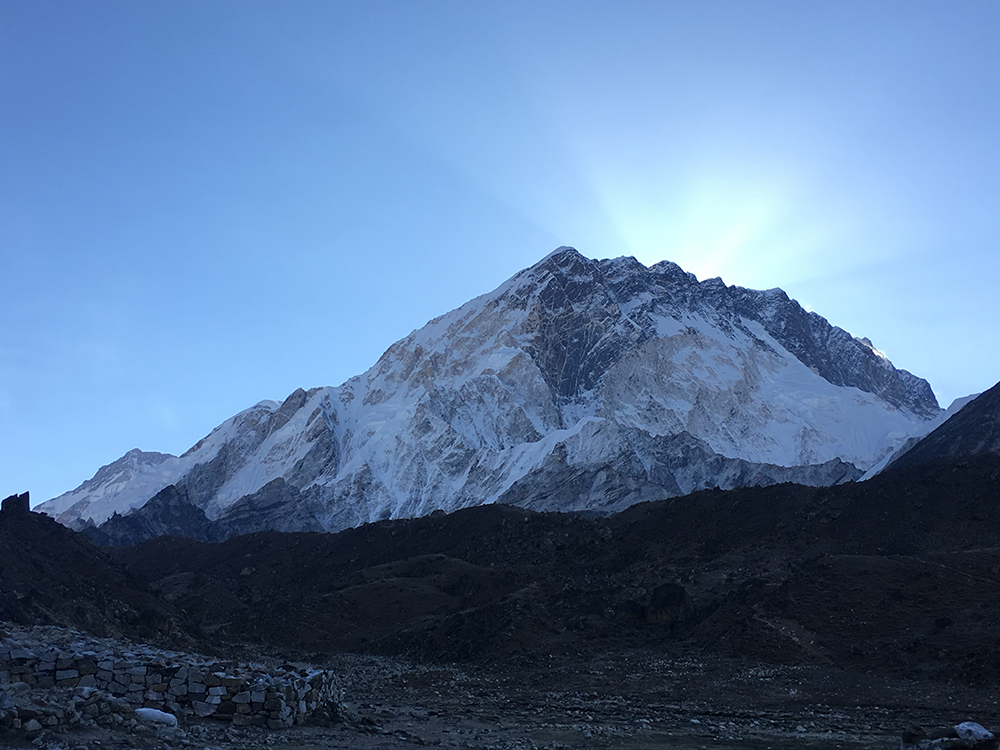 Today marks Everest Day as Edmund Hillary summited the highest mountain on Earth on 29th May 1953. It is also the day of the Everest marathon. 26.2 grueling miles from Base Camp to Namche over terrain which is difficult just to hike. With such little oxygen in the air I have no idea how the 300 runners manage it. We witnessed the leaders come through Lobuche at about 7am and passed many more on our hike towards base camp. There seemed to be a lot of Brits taking part and I have huge respect for them all.
Today marks Everest Day as Edmund Hillary summited the highest mountain on Earth on 29th May 1953. It is also the day of the Everest marathon. 26.2 grueling miles from Base Camp to Namche over terrain which is difficult just to hike. With such little oxygen in the air I have no idea how the 300 runners manage it. We witnessed the leaders come through Lobuche at about 7am and passed many more on our hike towards base camp. There seemed to be a lot of Brits taking part and I have huge respect for them all.
The first part of our hike took us up through the valley we had gazed upon the afternoon before but the weather wasn’t so good and this theme continued for the day. We passed through Gorak Shep where we would eventually stay the night, it was snowing by this point.
I had been experiencing the pressure headaches for the past few days but going on an acclimatisation hike always got rid of them and so I thought this would be the same today. However, an hour before reaching base camp I’d had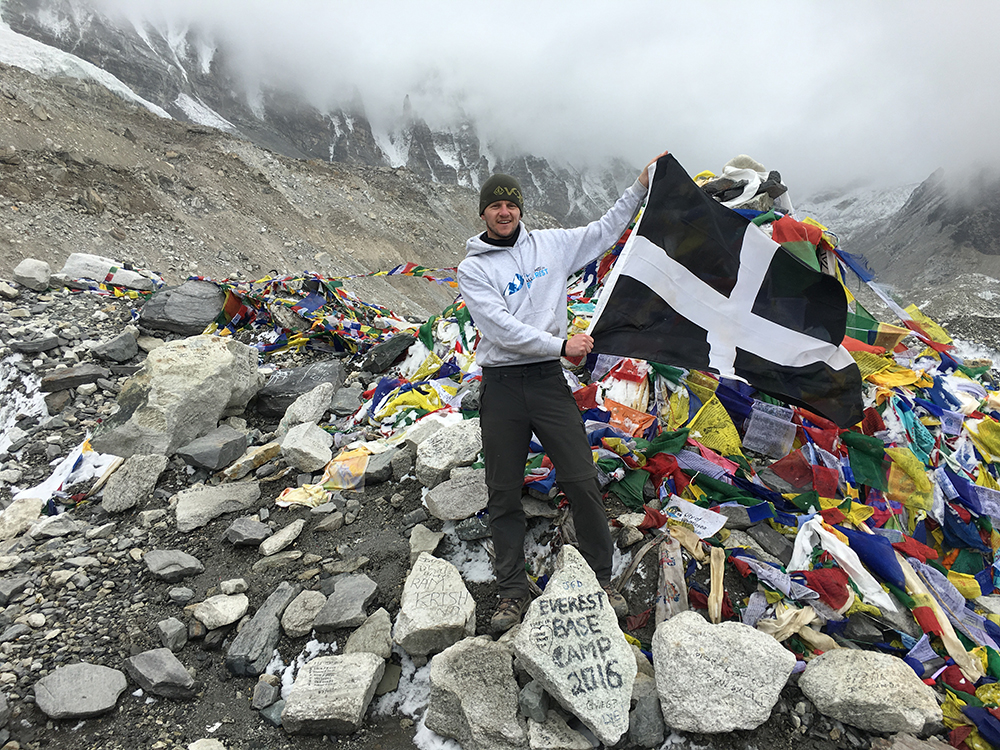 enough and reluctantly took the Diamox, an altitude sickness pill. I really wanted to do the whole challenge without it but by this point I wasn’t enjoying the hike. It did it’s job in about 30mins but also gives you the side effects of tingly face, fingers and toes, like pins and needles.
enough and reluctantly took the Diamox, an altitude sickness pill. I really wanted to do the whole challenge without it but by this point I wasn’t enjoying the hike. It did it’s job in about 30mins but also gives you the side effects of tingly face, fingers and toes, like pins and needles.
The last hour before our goal was tough. We hiked over huge boulders in low temperatures, strong winds and half the oxygen of that at sea level. Only a couple of days ago I was hiking in shorts and t-shirt but now I had most of my layers on and it was snowing. The fact that you’re raising money for an earthquake relief project in a poor country keeps you going.
Base camp lies close to the bottom of the Khumbu ice fall, the deadliest part of an Everest climb. It was both awe inspiring 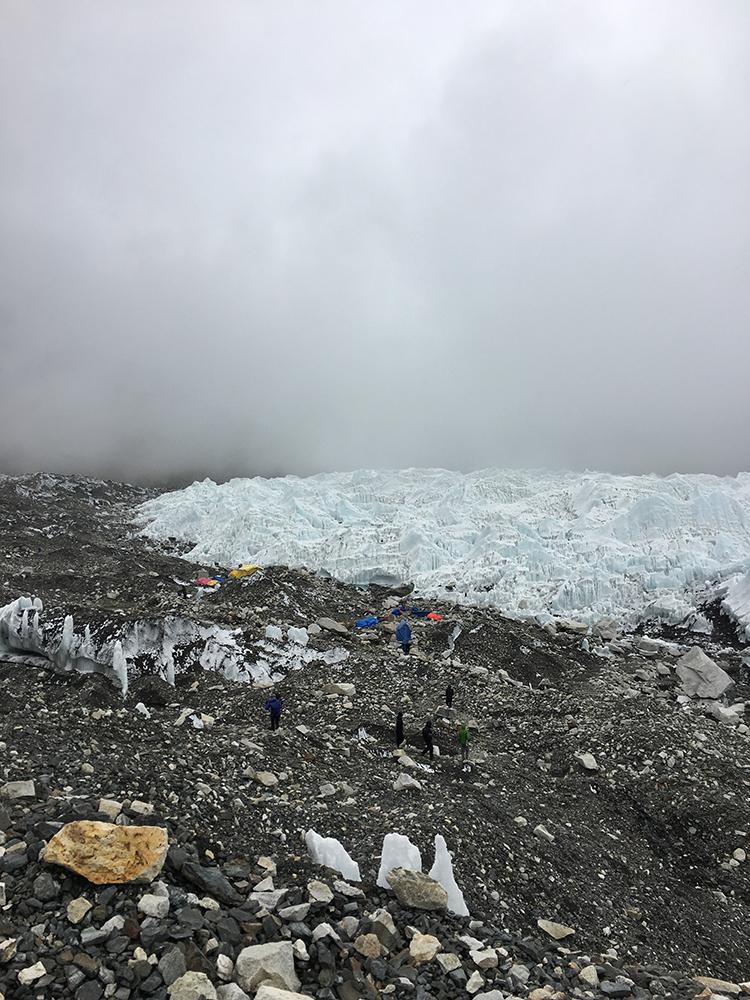 and terrifying to see it with your own eyes.
and terrifying to see it with your own eyes.
We finally reached base camp after 5 or 6 hours of hiking. It was an incredible feeling to complete our challenge. There were lots of high fives, hugs and the obligatory photos at the rock pile marking the entrance to the camp. After climbing for a week and gaining more than 2,000m in altitude, we’d done it. I pulled the Saint Piran’s flag from my bag and proudly posed for a view photos as well as signing one of the base camp stones with my name, the date and the name of the little Cornish village that i’m from. I have to say it was quite an emotional moment to be standing there with this fine team of people that i’d only 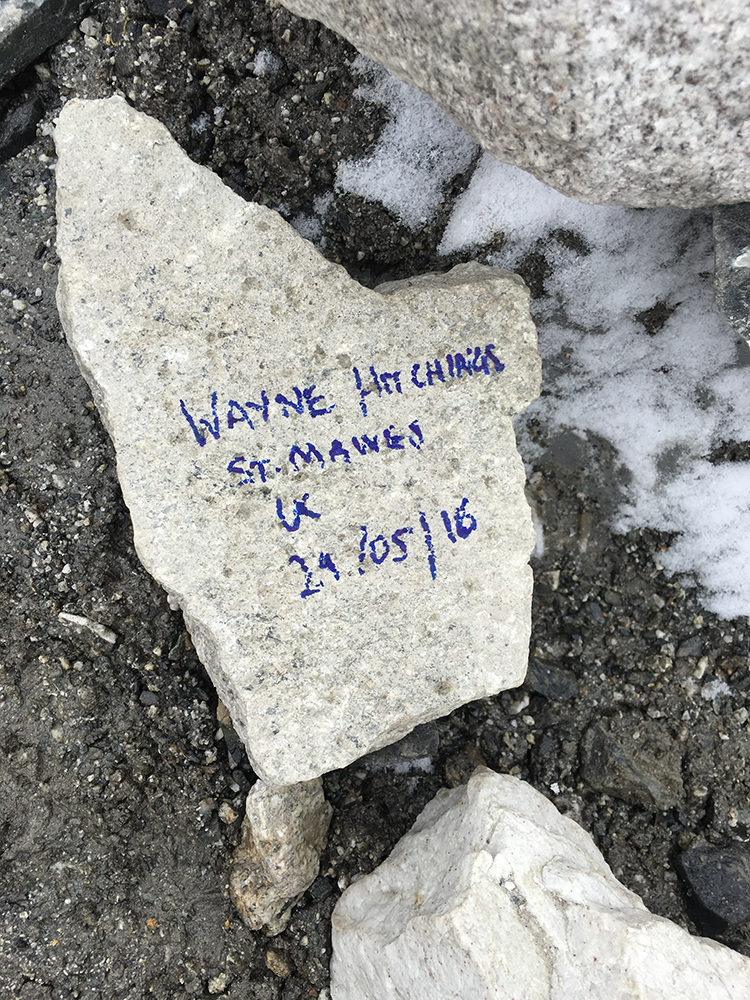 met a week ago. It was also odd to see so few tents at base camp itself. In the height of the season hundreds of tents swarm the edge of the glacier but at this late point in the climbing calendar only a small few remained. I wondered just where on the mountain their occupants might now be.
met a week ago. It was also odd to see so few tents at base camp itself. In the height of the season hundreds of tents swarm the edge of the glacier but at this late point in the climbing calendar only a small few remained. I wondered just where on the mountain their occupants might now be.
The hike back to Gorak Shep was perhaps expectedly a bit subdued. Your goal compete, the weather poor and everyone being very tired. For me personally, things took a turn for the worse. The headache returned along with some other symptoms that made me think I had caught a cold. It was freezing in the room and I got little sleep. A 3.30am wake up call to take on the hardest hike of the entire expedition was not what I needed!
13 June 2016
Day 6
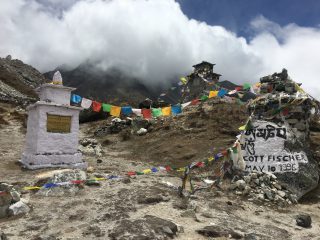 Dingbouche to Lobuche (4,300 – 4,930m)
Dingbouche to Lobuche (4,300 – 4,930m)
And there was me thinking that the views in Dingbouche were out of this world! Labouche was about to raise the bar once again but firstly to the hike itself. It was a pretty long one today with a steep section during the middle of the day. The weather was hot and sunny.
It seems quite strange to be well over 4,000m in altitude and still be able to hike in shorts and t-shirt. Spirits among the group were as high as they had been since the start of the trip after yesterday’s stunning vistas. We had lunch in a place called Tukla and just like almost all other days this meant rice and more rice. Very filling and full of carbohydrates but not so useful today because immediately after lunch we had a very steep climb that lasted about 45 minutes and you definitely regretted the full stomach.
At the top of the steep section we entered a large open space full of stone cairns built in memory to those who had taken on the world’s highest peaks but were never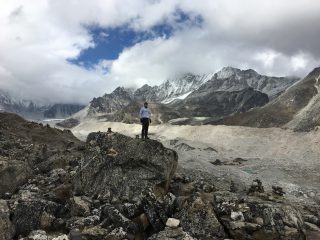 to return home. It was quite a harrowing experience to see the sheer scale of it. There were famous names like Scott Fischer (familiar to anyone who has read ‘Into Thin Air’ or seen the movie ‘Everest’) and I saw one for a young lady who had been killed at base camp by the avalanche that hit as a result of the earthquake. This was the one which most struck a chord with me since we were going there as a disaster relief charity raising money to help Nepal recover from the very same earthquake that had claimed the life of this young explorer.
to return home. It was quite a harrowing experience to see the sheer scale of it. There were famous names like Scott Fischer (familiar to anyone who has read ‘Into Thin Air’ or seen the movie ‘Everest’) and I saw one for a young lady who had been killed at base camp by the avalanche that hit as a result of the earthquake. This was the one which most struck a chord with me since we were going there as a disaster relief charity raising money to help Nepal recover from the very same earthquake that had claimed the life of this young explorer.
We had arrived in Lobuche by mid-afternoon but once again, Nema informed us that we needed to go on another acclimatisation hike after tea. He gave us a choice this time. We could take a relatively flat route up through the valley or climb a steep ridge where we would get views of the Khumbu Glacier. I think a good proportion of the group liked the sound of the easy option but those of us who are excited by things such as glaciers quickly out voiced any opponents with our excitement and the decision was made. I’m not sure if it influenced any of the others but I personally knew that taking the steep ridge option would lift us through the 5,000m mark and that really appealed to me despite the fact that I was suffering from headaches again.
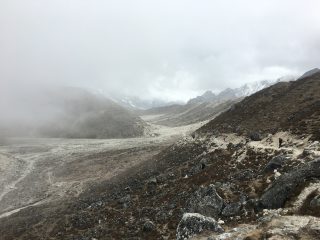 Once we were up on top of the ridge everyone was thankful that we had taken the tougher route because the views were absolutely incredible. The sun setting behind the Himalayas, the air now much cooler than earlier in the day and the Khumbu Glacier in full view. It was an afternoon I will never forget. Looking both up and down the valley you could see just how far the glacier has retreated, perhaps by several kilometres from where it once was, leaving behind these deep gouges in the mountain and a clear line of the height it reached which reminded me a lot of a tide line that you might see on a wall or beach. We stayed on the ridge for more than an hour taking lots of photos and wearing enormous smiles before returning to our accommodation for some well-earned sleep.
Once we were up on top of the ridge everyone was thankful that we had taken the tougher route because the views were absolutely incredible. The sun setting behind the Himalayas, the air now much cooler than earlier in the day and the Khumbu Glacier in full view. It was an afternoon I will never forget. Looking both up and down the valley you could see just how far the glacier has retreated, perhaps by several kilometres from where it once was, leaving behind these deep gouges in the mountain and a clear line of the height it reached which reminded me a lot of a tide line that you might see on a wall or beach. We stayed on the ridge for more than an hour taking lots of photos and wearing enormous smiles before returning to our accommodation for some well-earned sleep.
Tomorrow is the big day. Base Camp awaits.
3rd June 2016:
Tyangbouche to Dingbouche (3,867 – 4,300m)
Where do I start with this post. Perhaps I should forget words and just post lots of photos. The weather has generally been better first thing in the mornings. We have been waking at around 5am each day and had heard the views from Tyangbouche are incredible. But, much like last night, the morning weather was full cloud cover. Everyone was disappointed.
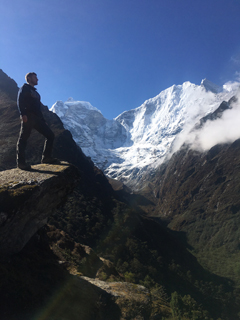 The mountain weather can change very quickly and in just 15mins the cloud was gone. Hidden from us for so long, the giants appeared. Everest, Lhotse, Nuptse all in full view. We ran around like children on Christmas Eve snapping photos in all directions. The views were staggering. It is a day I will never forget.
The mountain weather can change very quickly and in just 15mins the cloud was gone. Hidden from us for so long, the giants appeared. Everest, Lhotse, Nuptse all in full view. We ran around like children on Christmas Eve snapping photos in all directions. The views were staggering. It is a day I will never forget.
When the guides finally managed to get us moving we had a steady morning hike. The sun was out and the incredible views remained. After lunch the hike became a lot tougher and as we passed 4,000m many of the group, myself included, began to feel the altitude for the first time. It gives you a headache and you feel like there is a slight pressure on your head.
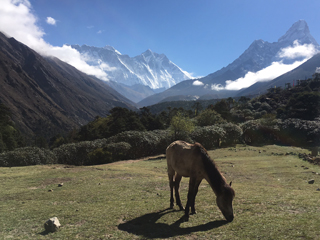 We arrived in Dingbouche after hiking for around 6 hours but our day wasn’t finished. Nema, our lead guide, had a surprise for us. Not a good one. Apparently now we were over 4,000m we had to acclimatise and that meant another 300m uphill after we’d checked in. By now the weather had come in and it was cold. Nobody wanted to do it but we’d learned our lesson in question his judgement. Right now it’s dinner time and that means Dahlbaat. “Power for 24 hours” so they say. I’ll need it. Tomorrow we cross through 5,000m.
We arrived in Dingbouche after hiking for around 6 hours but our day wasn’t finished. Nema, our lead guide, had a surprise for us. Not a good one. Apparently now we were over 4,000m we had to acclimatise and that meant another 300m uphill after we’d checked in. By now the weather had come in and it was cold. Nobody wanted to do it but we’d learned our lesson in question his judgement. Right now it’s dinner time and that means Dahlbaat. “Power for 24 hours” so they say. I’ll need it. Tomorrow we cross through 5,000m.
I hope to be able to update you again soon.
Day 4
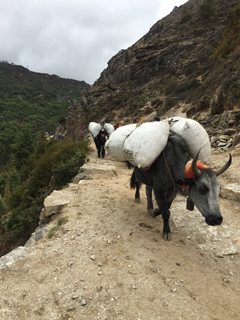 Namche to Tyangbouche (3,350 – 3,867)
Namche to Tyangbouche (3,350 – 3,867)
The challenge got a little more difficult today with the hike to Tyangbouche. Climbing more than 500m the last 2-3 hours were much steeper than we’d experienced so far.
I learnt a valuable lesson in listening to what the guide tells you. Having hiked a lot before I am used to going at my pace and felt for the first few days the pace was slow. 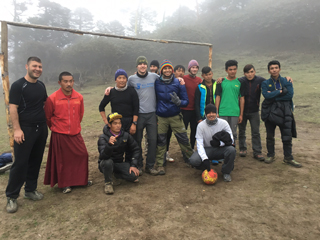 Today I understood why it was slow! As the air got thinner and the mountain steeper, it got much harder to breathe.
Today I understood why it was slow! As the air got thinner and the mountain steeper, it got much harder to breathe.
In Tyangbouche we went to the monastery and watched the monks chanting. Afterwards I got myself involved in a football match. It  wasn’t exactly tiki-taka but I’ve never played football with monks and Sherpas before and it was a lot of fun. I do know that it will be the most difficult game I’ll ever play. Running around at 3,800m is hard! Even after one short sprint you struggle to catch your breath.
wasn’t exactly tiki-taka but I’ve never played football with monks and Sherpas before and it was a lot of fun. I do know that it will be the most difficult game I’ll ever play. Running around at 3,800m is hard! Even after one short sprint you struggle to catch your breath.
The weather was cloudy all day but we did get our first tantalising glimpse of Everest. It was only the summit and didn’t last long before the clouds closed up again.
Tomorrow we climb to Dingbouche and break the 4,000m barrier which I’m very excited about.
25th May 2016:
The Trek
Day 1
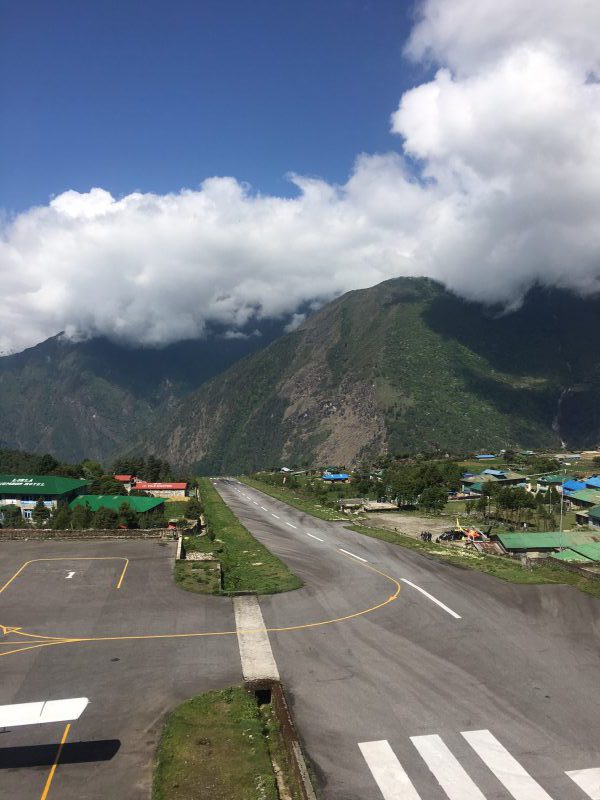 The plane ride from Kathmandu to Lukla, our gateway to Everest, was probably the scariest thing we will do on this trip. Forget the altitude risks, this little 20 seater plane got bumped around all over the place but worse was to come with the landing. The runway in Lukla is built into the side of the mountain. It is just 500m long and 15m wide with a 17deg incline. However, none of this matters when you consider the breathtaking views of the Himalayas that you get in the flight in. Flying above the clouds these giants still tower above you. A glimpse of what is yet to come.
The plane ride from Kathmandu to Lukla, our gateway to Everest, was probably the scariest thing we will do on this trip. Forget the altitude risks, this little 20 seater plane got bumped around all over the place but worse was to come with the landing. The runway in Lukla is built into the side of the mountain. It is just 500m long and 15m wide with a 17deg incline. However, none of this matters when you consider the breathtaking views of the Himalayas that you get in the flight in. Flying above the clouds these giants still tower above you. A glimpse of what is yet to come.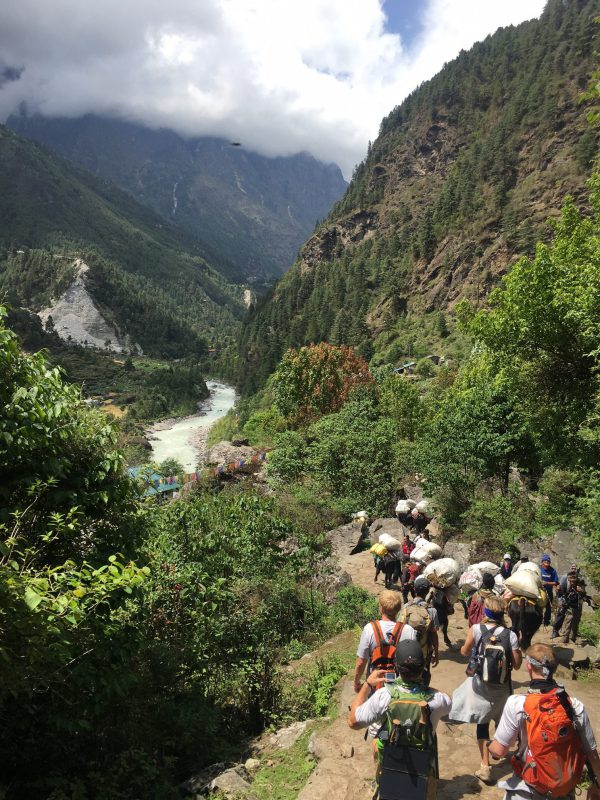
The hiking today was very comfortable. Just a few short hours where we actually dropped in altitude from 2,800m to just over 2,600m. A nice way to start before it gets tough.
We stayed in the village of Phakding. There was actually an aftershock during the night. It wasn’t huge but was enough to shake the wood cabin and wake you.
Day’s 2 and 3 – Phakding to Namche (2,600m to 3,440m)
The first couple of hours of today’s hike were relatively easy. We travelled for several miles but remained at a steady altitude. After our morning break this all changed as we spent the rest of the day climbing more than 700m to our overnight stay in the village of Namche (3,440m). The change in altitude will be our largest for any single day of this challenge.
The conditions were kind to us with cooler weather and cloud cover blocking out the harsh sunlight.
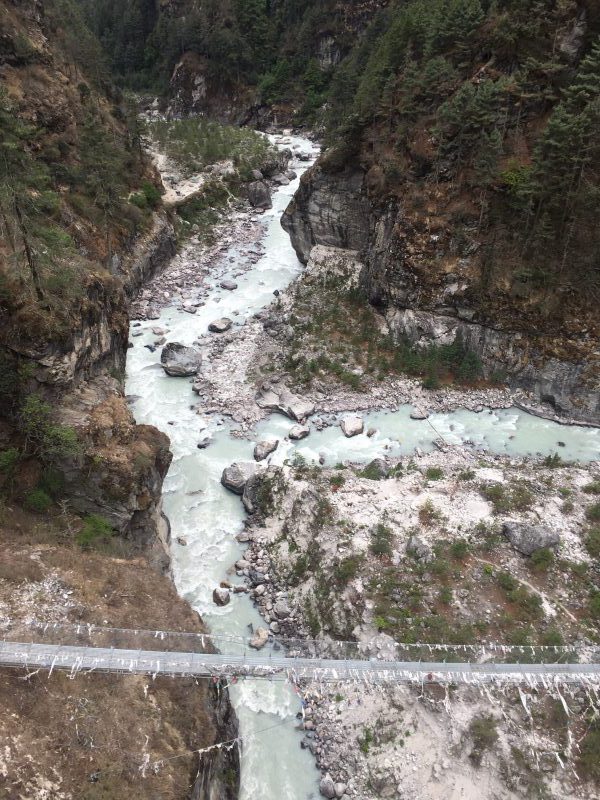 The afternoon climb was quite physically draining but the hardest thing for me today were the bridge crossings. One in particular was several hundred feet above the valley floor and for someone that doesn’t like heights this wasn’t much fun.
The afternoon climb was quite physically draining but the hardest thing for me today were the bridge crossings. One in particular was several hundred feet above the valley floor and for someone that doesn’t like heights this wasn’t much fun.
When we reached Namche one of our team was showing signs of altitude sickness but thankfully after a good night’s sleep she recovered. We got sad news that in 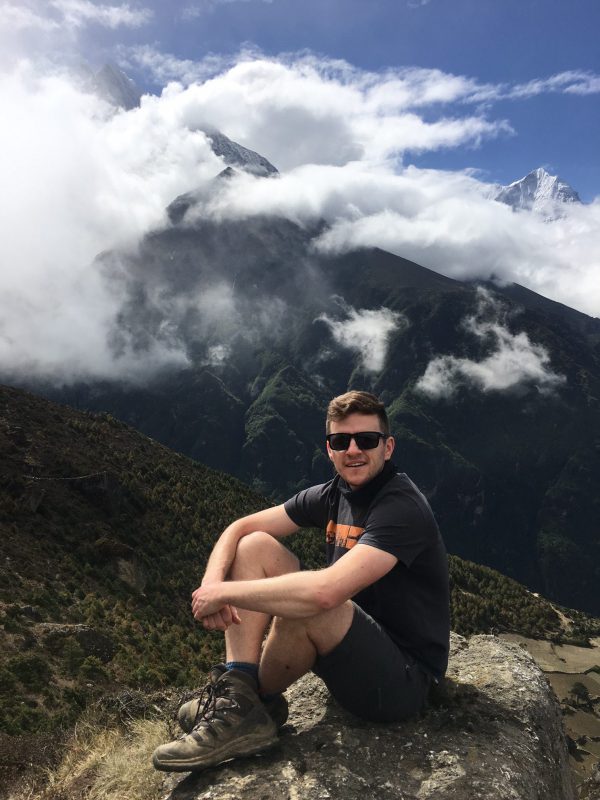 the last 2 days, 7 people had been killed on Everest, 4 of them on the Nepalese side. All 4 died of acute altitude sickness on the way down having already summited.
the last 2 days, 7 people had been killed on Everest, 4 of them on the Nepalese side. All 4 died of acute altitude sickness on the way down having already summited.
Day 3 was a “rest day” in Namche but we still did a 3 hour hike up to a view point at 3,880m. This was a new personal best for me so I was very excited! As you can see from the photos the views were absolutely stunning. There was too much cloud cover to see Everest today but hopefully that will come soon.
That’s all for now. I hope to be able to update you soon.
Thanks
Wayne
21st May 2016:
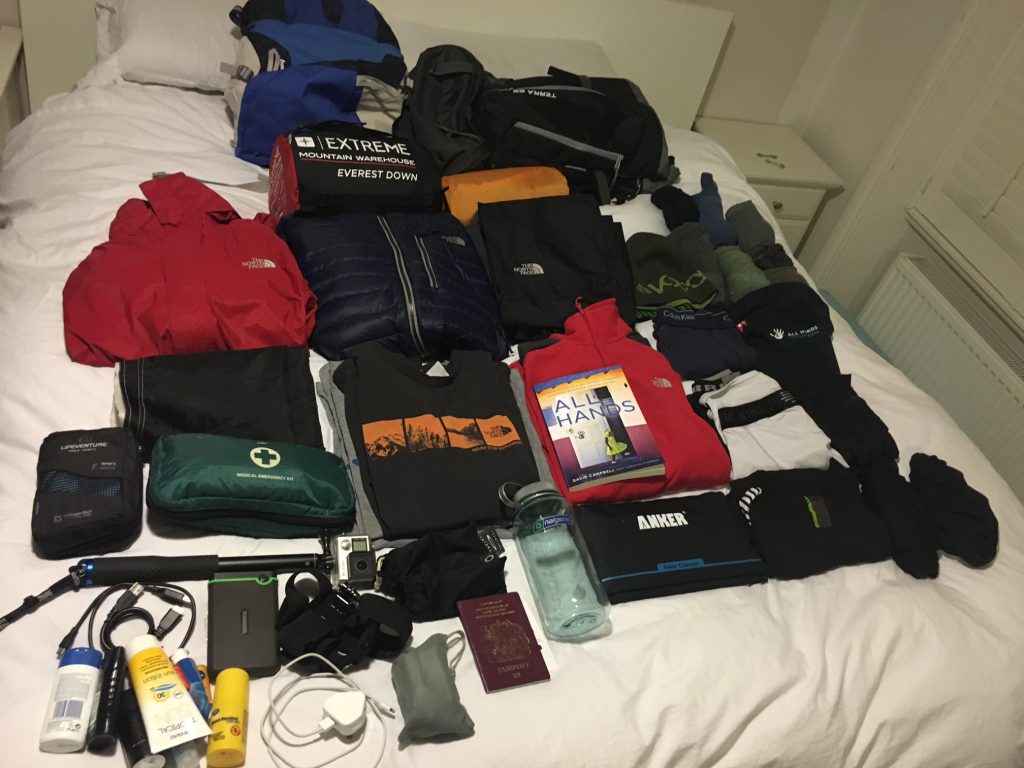
Well, I am about to fly to Nepal and by Monday I’ll be on the world’s highest mountain. My overwhelming feeling is one of excitement with a hint of apprehension in there for good measure. Before I could even think about getting on the plane came the packing, and with a kit list as long as both your arms I was worried that I wouldn’t fit it all in. A 150l base camp bag solved that problem! From a sleeping bag with a ‘comfort’ temperature of -3 to -9 degC to a medical kit where I don’t actually know what half the things are meant to treat, I think I have everything. There’s no way I was going to climb this big hill without taking a piece of home with me. Kernow bys Vyken.
Some of my colleagues have asked whether I’m scared that something might go wrong or worried about it at all.
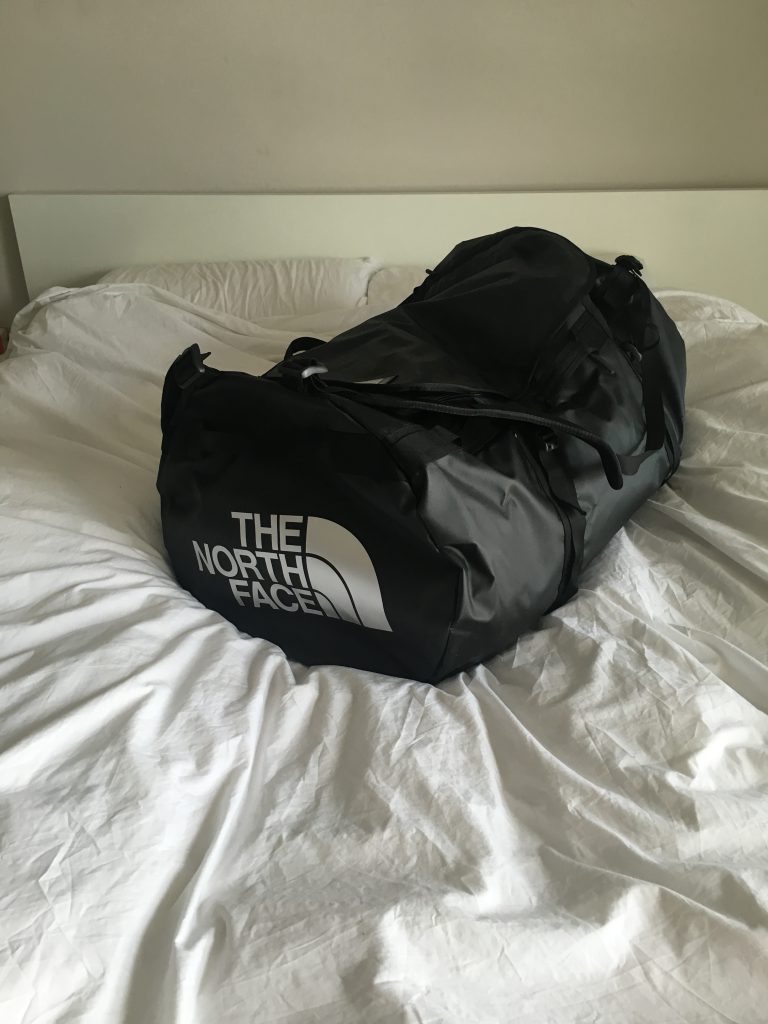
They refer to the earthquake causing the avalanche which hit base camp and killed 19 people. The single deadliest day in the history of climbing Everest. Well, the chances of that happening again in the next fortnight are very small. What I fear the most is failure. So many people have supported me that if I don’t complete the challenge I will feel that I’ve failed and let people down. I can use that fear though to get me up the mountain.
What about what I’m looking forward to? The views of course! I’ve always dreamt of seeing the big guy from up close, hear’s hoping for clear weather. Also, the feeling of completing a tough challenge is always a fantastic one. I cannot wait to be back on the project. When I was there last year, shortly after the earthquake, there was still a lot of damage and destruction. Our days were spent demolishing unsafe buildings and clearing up the rubble so it will be such a great feeling to see things being built again. Then there’s the Nepali people who are a joy to be around.
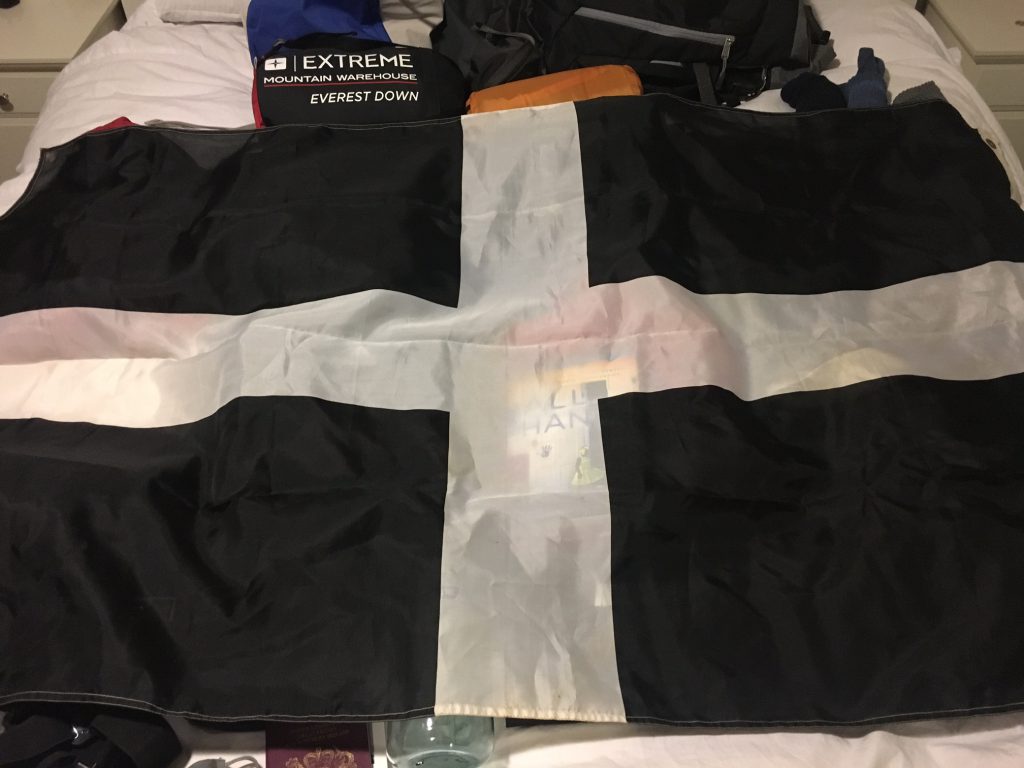
Before I go I’d like to thank everyone who has donated to my fundraising page which is currently at more than £2,800. I never imagined it would reach those heights, your generosity is humbling. If you haven’t already donated please consider doing so, it’s such a great cause. The link to my page is at the top of this blog.
I won’t have any internet access for the 3 weeks I’m in Nepal so please bear with me and I’ll update you with how the challenge went, how the project is progressing and hopefully some amazing photos when I return.
Until then, take care of yourselves and enjoy the Bank Holiday weekend.
Namaste!
Wayne
18th May 2016:
Training
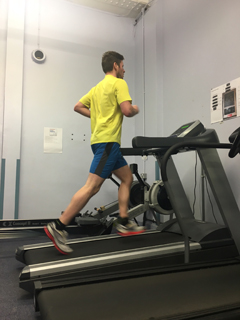 When I signed up for this challenge I wasn’t really sure what sort of training regime I should set for myself. How should I train? Is there anything I should focus on? How long before the hike should I start training? and to be honest i’m still not sure whether i’ve trained enough or not!
When I signed up for this challenge I wasn’t really sure what sort of training regime I should set for myself. How should I train? Is there anything I should focus on? How long before the hike should I start training? and to be honest i’m still not sure whether i’ve trained enough or not!
Physically, I think i’m in pretty reasonable shape. I’ve been going to the gym for 4-5 days a week working on strength training, mainly in the legs, and also some cardio training on the treadmill. I’ve also done a fair amount of hiking before but never to this altitude and that is my biggest concern.
My highest to date is the 3,776m summit of Mt Fuji in Japan but on this challenge i’ll be going to 5,554m. At that altitude there is just 50{c8c3b3d140ed11cb7662417ff7b2dc686ffa9c2daf0848ac14f76e68f36d0c20} of the Oxygen in the air compared to sea level so I know that’s going to be tough to deal with and i’ve not been able to do any altitude training at all.
Then of course there is the mind. In my 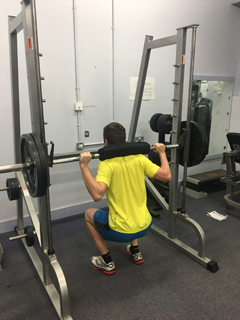 hiking experience this has often been the hardest thing to overcome. When your head is telling you that your body is tired. My comfort here is knowing that I’m doing this with a team and not just any team! We are all part of the All Hands family and I know that we’ll get each other to the top.
hiking experience this has often been the hardest thing to overcome. When your head is telling you that your body is tired. My comfort here is knowing that I’m doing this with a team and not just any team! We are all part of the All Hands family and I know that we’ll get each other to the top.
I don’t yet know any of the others but they are all disaster relief volunteers which makes them a tough bunch. Teamwork is what helps us achieve so much in response to a natural disaster like the earthquake in Nepal.
Lastly, the biggest driver. Knowing that everything we’ve raised through taking on this challenge is going to help the people who desperately need it. Children who’s school has fallen down, families who have lost loved ones, their homes destroyed and without money to rebuild. We’re giving them hope.
Thank you
Wayne
11th May 2016:
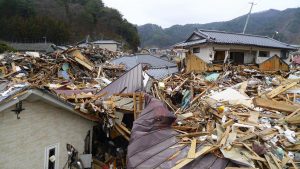
Who are AHV?
All Hands Volunteers are a disaster relief charity founded in 2004 after the Indian Ocean tsunami. Over the past 12 years we have responded to more than 60 natural disasters including the Haiti earthquake in 2010, the Japanese tsunami in 2011, super typhoon Haiyan in the Philippines in 2013 and of course, the Nepal earthquake of 2015. In that time over 35,000 volunteers have donated 175,000 days and impacted half a million people all over the world. I cannot express enough the incredible work that this charity does and the direct impact they have on those who have been worst affected.
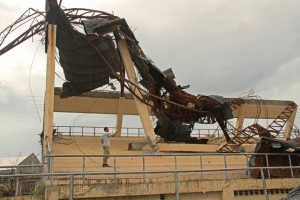
The Nepal earthquake response is my 3rd project with AHV. My first was another earthquake project on the island of Bohol in the Philippines, in 2013. My experiences there changed me as a person, my outlook, what was important to me and a realisation that volunteering, in particular disaster volunteering, was the most immensely rewarding experience you could ever imagine. I worked with around 100 other volunteers from the UK, USA, Brazil, Germany, Australia, New Zealand, Hong Kong, Singapore, Canada, France, Spain and many more. A truly international effort and all with one simple, common goal – to help people.
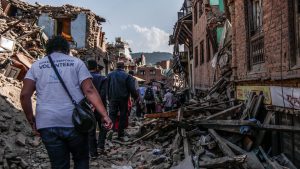
I’ve sometimes been asked why I would pay a lot of money to fly half way across the world using my annual leave to work really hard for free. The answer is easy. I promise you that someone putting numbers into your bank account each month could never make you feel like this does.
That’s all for now. In the next post or two I shall talk more about the Everest Challenge itself and my preparations for it. Only 11 days to go!
As always if you have any questions please ask.
Thanks
Wayne
5th May 2016:
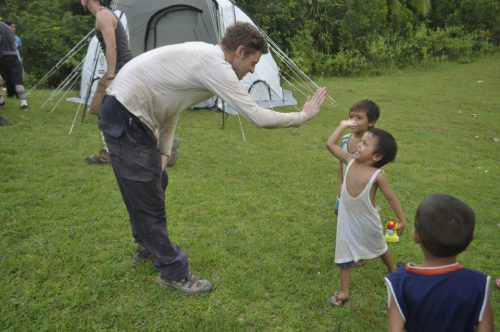 Hi All,
Hi All,
I thought I would introduce myself a little further after the original post. As I mentioned, I was born and grew up in St.Mawes, attending the primary school before going on to The Roseland School and St. Austell College. Like most Cornish people I couldn’t imagine a better county to spend your childhood in and I loved being by the sea. Whether it was sailing, surfing, fishing or football, I felt so lucky to have been born in Cornwall.
This upbringing has given me a real sense of perspective when volunteering with All Hands Volunteers on disaster relief projects. The Nepal project is the second earthquake response I’ve worked on after my first in the Philippines in 2013. My favourite sites are always the schools. The children are so friendly and interested in you. They give you such a lift even when you’re so tired from the laborious work in the hot and humid conditions. Just like growing up on the Cornish coast, they too have beautiful scenery to gaze upon each day but that is where the similarities end. Both of the countries are very poor and in Nepal I met children as young as 4 walking more than an hour to school each day, their parents working all hours just to put food on the table. A far cry from the school bus and as much food as you could ever wish to eat.
The 3 weeks I spent in Nepal last June were largely demolishing badly damaged school buildings and clearing up the rubble. This time around, after the Everest challenge is completed, I hope to be building new, earthquake-resilient, schools. Although the full rebuilding and recovery will take many years, on a personal level it will feel like some sort of completeness to have been taking down unsafe buildings and then building new one’s to replace them. You can help us rebuild hope in Nepal by donating to my fundraising page www.justgiving.com/Wayne-Hitchings
That’s all for now but if you have any questions please post them below and i’ll do my best to answer them.
Have a good day,
Wayne
 1st May 2016: Hello, my name is Wayne Hitchings. I’m 33 years old and I grew up in St. Mawes. I am a volunteer with All Hands Volunteers who are a disaster response charity.
1st May 2016: Hello, my name is Wayne Hitchings. I’m 33 years old and I grew up in St. Mawes. I am a volunteer with All Hands Volunteers who are a disaster response charity.
At the end of May 2016 I will be part of a 20 person team made up of volunteers from across the world, attempting to hike to Everest Base Camp in order to raise money for the people most affected by the Nepal earthquake. The challenge will take around 12 days to complete with 5-9 hours of hiking each day and a couple of rest days along the way. With an altitude of 5,364m and just 50{c8c3b3d140ed11cb7662417ff7b2dc686ffa9c2daf0848ac14f76e68f36d0c20} of the oxygen in the air compared to sea level, it promises to be tough!
Why am I doing it?
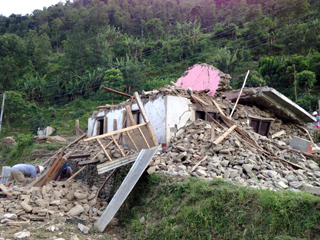 The 25th April 2016 marked the one year anniversary of the 7.8 magnitude earthquake which killed more than 8000 people and destroyed half a million homes in one of the world’s poorest countries. One year on many of the worst affected areas in the difficult to reach regions remain in desperate need of help.
The 25th April 2016 marked the one year anniversary of the 7.8 magnitude earthquake which killed more than 8000 people and destroyed half a million homes in one of the world’s poorest countries. One year on many of the worst affected areas in the difficult to reach regions remain in desperate need of help.
All Hands Volunteers are there right now, building earthquake-resilient schools to replace those that collapsed in the Nuwakot region of the country. Having spent 3 weeks on the project last year, shortly after the earthquake struck, I can testify to the incredible work that this charity is doing. After the challenge is completed (successfully I hope!) I will re-join the project for a further week.
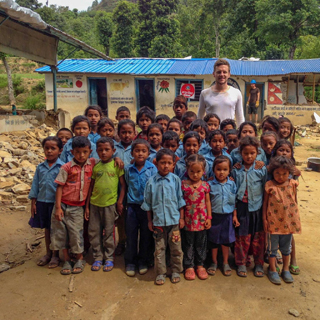 I would be extremely grateful if you could take a couple of minutes to look at my fundraising page and consider making a donation to help me reach my £2,500 target. The more money that is raised the more schools get built and the longer the charity can remain in Nepal. Any donations made before May 12 will be 100{c8c3b3d140ed11cb7662417ff7b2dc686ffa9c2daf0848ac14f76e68f36d0c20} matched by the charity’s founder! You’ll find my fundraising page at www.justgiving.com/Wayne-Hitchings
I would be extremely grateful if you could take a couple of minutes to look at my fundraising page and consider making a donation to help me reach my £2,500 target. The more money that is raised the more schools get built and the longer the charity can remain in Nepal. Any donations made before May 12 will be 100{c8c3b3d140ed11cb7662417ff7b2dc686ffa9c2daf0848ac14f76e68f36d0c20} matched by the charity’s founder! You’ll find my fundraising page at www.justgiving.com/Wayne-Hitchings
I will be writing a blog throughout the expedition exclusively for Roseland Online so that you can keep up to date with our progress and ask any questions that you may have. Please feel free to drop in any time and follow my progress.
 In the mean time you’ll find more information on my fundraising page at the link above and you can see the work we’ve done over the past year in Nepal by watching this 2.5min video http://hands.org/nepal-earthquake-one-year-anniversary/
In the mean time you’ll find more information on my fundraising page at the link above and you can see the work we’ve done over the past year in Nepal by watching this 2.5min video http://hands.org/nepal-earthquake-one-year-anniversary/
Thank you for now,
Wayne


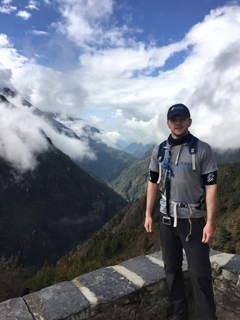
Barrie,
Thank you very much for your kind comments and generous donation to my fundraising page.
Wayne
Well done cap good luck to you looks amazing, St mawes man on everest brilliant
Barrie & Brenda